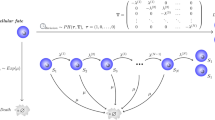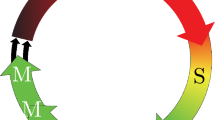Abstract
The fluorescent dye carboxyfluorescin diacetate succinimidyl ester (CFSE) classifies proliferating cell populations into groups according to the number of divisions each cell has undergone (i.e., its division class). The pulse labeling of cells with radioactive thymidine provides a means to determine the distribution of times of entry into the first cell division. We derive in analytic form the number of cells in each division class as a function of time using the cyton approach that utilizes independent stochastic distributions for the time to divide and the time to die. We confirm that our analytic form for the number of cells in each division class is consistent with the numerical solution of a set of delay differential equations representing the generalized Smith–Martin model with cell death rates depending on the division class. Choosing the distribution of time to the first division to fit thymidine labeling data for B cells stimulated in vitro with lipopolysaccharide (LPS) and either with or without interleukin-4 (IL-4), we fit CFSE data to determine the dependence of B cell kinetic parameters on the presence of IL-4. We find when IL-4 is present, a greater proportion of cells are recruited into division with a longer average time to first division. The most profound effect of the presence of IL-4 was decreased death rates for smaller division classes, which supports a role of IL-4 in the protection of B cells from apoptosis.
Similar content being viewed by others
References
Asquith, B., Debacq, C., Florins, A., Gillet, N., Sanchez-Alcaraz, T., Mosley, A., Willems, L., 2006. Quantifying lymphocyte kinetics in vivo using carboxyfluorescein diacetate succinimidyl ester (CFSE). Proc. R. Soc. B 273, 1165–1171.
Bernard, S., Pujo-Menjouret, L., Mackey, M.C., 2003. Analysis of cell kinetics using a cell division marker: mathematical modeling of experimental data. Biophys. J. 84, 3414–3424.
Bird, J.J., Brown, D.R., Mullen, A.C., , 1998. Helper T cell differentiation is controlled by the cell cycle. Immunity 9, 229–237.
Brooks, R.F., Bennett, D.C., Smith, J.A., 1980. Mammalian cell cycles need two random transitions. Cell 19, 493–504.
Cory, S., Huang, D.C., Adams, J.M., 2003. The Bcl-2 family: roles in cell survival and oncogenesis. Oncogene 22, 8590–8607.
De Boer, R.J., Perelson, A.S., 2005. Estimating division and death rates from CFSE data. J. Comput. Appl. Math. 184, 140–164.
De Boer, R.J., Ganusov, V.V., Milutinovic, D., Hodgkin, P.D., Perelson, A.S., 2006. Estimating lymphocyte division and death rates from CFSE data. Bull. Math. Biol. 68, 1011–1031.
Deenick, E.K., Hasbold, J., Hodgkin, P.D., 1999a. Switching to IgG3, IgG2b, and IgA is division linked and independent, revealing a stochastic framework for describing differentiation. J. Immunol. 163, 4707–4714.
Deenick, E.K., Hasbold, J., Hodgkin, P.D., 1999b. Switching to IgG3, IgG2b, and IgA is division linked and independent, revealing a stochastic framework for describing differentiation. J. Immunol. 163, 4707–4714.
Deenick, E.K., Gett, A.V., Hodgkin, P.D., 2003. Stochastic model of T cell proliferation: a calculus revealing IL-2 regulation of precursor frequencies, cell cycle time, and survival. J. Immunol. 170, 4963–4972.
Dufort, F.J., Beiman, B.F., Gumina, M.R., Blair, D., Wagner, D.J., Roberts, M.F., Abu-Amer, Y., Chiles, T.C., 2007. IL-4-mediated protection of primary B lymphocytes from apoptosis via Stat6-dependent regulation of glycolytic metabolism. J. Immunol. 179, 4953–4957.
Efron, B., Tibshirani, R., 1986. Bootstrap methods for standard errors, confidence intervals, and other measures of statistical accuracy. Stat. Sci. 1, 54–77.
Fazekas de St Groth, B., Smith, A.L., Koh, W.-P., Girgis, L., Cook, M.C., Bertolino, P., 1999. Carboxyfluorescein diacetate succinimidyl ester and the virgin lymphocyte: A marriage made in heaven. Immnol. Cell Biol. 77, 530–538.
Ganusov, V.V., Pilyugin, S.S., De Boer, R.J., Murali-Krishna, K., Ahmed, R., Antia, R., 2005. Quantifying cell turnover using CFSE data. J. Immunol. Methods 298, 183–200.
Ganusov, V.V., Milutinovic, D., De Boer, R.J., 2007. IL-2 regulates expansion of CD4+ T cell populations by affecting cell death: insights from modeling CFSE data. J. Immunol. 179, 950–957.
Gascan, H., Gauchat, J.F., Roncarolo, M.G., Yssel, H., Spits, H., de Vries, J.E., 1991. Human B cell clones can be induced to proliferate and to switch to IgE and IgG4 synthesis by interleukin 4 and a signal provided by activated CD4+ T cell clones. J. Exp. Med. 173, 747–750.
Gett, A.V., Hodgkin, P.D., 1998. Cell division regulates the T cell cytokine repertoire, revealing a mechanism underlying immune class regulation. Proc. Natl. Acad. Sci. USA 95, 9488–9493.
Gett, A.V., Hodgkin, P.D., 2000. A cellular calculus for signal integration by T cells. Nat. Immunol. 1, 239–244.
Guo, B., Blair, D., Chiles, T.C., Lowell, C.A., Rothstein, T.L., 2007. B cell receptor (BCR) cross-talk: the IL-4-induced alternate pathway for BCR signaling operates in parallel with the classical pathway, is sensitive to Rottlerin, and depends on Lyn. J. Immunol. 178, 4726–4730.
Hasbold, J.A., Lyons, A.B., Kehry, M.R., Hodgkin, P.D., 1998. Cell division number regulates IgG1 and IgE switching of B cells following stimulation by CD40 ligand and IL-4. Eur. J. Immunol. 28, 1040–1051.
Hawkins, E.D., Turner, M.L., Dowling, M.R., van Gend, C., Hodgkin, P.D., 2007. A model of immune regulation as a consequence of randomized lymphocyte division and death times. Proc. Natl. Acad. Sci. USA 104, 5032–5037.
Hodgkin, P.D., Go, N.F., Cupp, J.E., Howard, M., 1991. Interleukin-4 enhances anti-IgM stimulation of B cells by improving cell viability and by increasing the sensitivity of B cells by improving cell viability and by increasing the sensitivity of B cells to the anti-IgM signal. Cell. Immunol. 134, 14–30.
Hodgkin, P.D., Lee, J.H., Lyons, A.B., 1996. B cell differentiation and isotype switching is related to division cycle number. J. Exp. Med. 184, 277–281.
Illera, V.A., Perandones, C.E., Stunz, L.L., Mower, D.A. Jr., Ashman, R.F., 1993. Apoptosis in splenic B lymphocytes. Regulation by protein kinase C and IL-4. J. Immunol. 151, 2965–2973.
Lee, H.Y., Perelson, A.S., 2008. Modeling T cell proliferation and death in vitro based on labeling data: generalizations of the Smith-Martin cell cycle model. Bull. Math. Biol. 70, 21–44.
Leon, K., Faro, J., Carneiro, J., 2004. A general mathematical framework to model generation structure in a population of asynchronously dividing cells. J. Theor. Biol. 229, 455–476.
Lyons, A.B., 2000. Analyzing cell division in vivo and in vitro using flow cytometric measurement of CFSE dye dilution. J. Immunol. Methods 243, 147–154.
Lyons, A.B., Parish, C.R., 1994. Determination of lymphocyte division by flow cytometry. J. Immunol. Methods 171, 131–137.
Nordon, R.E., Nakamura, M., Ramirez, C., Odell, R., 1999. Analysis of growth kinetics by division tracking. Immunol. Cell. Biol. 77, 523–529.
Nurse, P., 2000. A long twentieth century of the cell cycle and beyond. Cell 100, 71–78.
Pene, J., Rousset, F., Briere, F., Chretien, I., Bonnefoy, J.-Y., Spits, H., Yokota, T., Arai, N., Arai, K., Banchereau, J., de Vries, J.E., 1988. IgE production by normal human lymphocytes is induced by interleukin 4 and suppressed by interferons γ and α and prostaglandin E2. Proc. Natl. Acad. Sci. 85, 6880–6884.
Pilyugin, S.S., Ganusov, V.V., Murali-Krishna, K., Ahmed, R., Antia, R., 2003. The rescaling method for quantifying the turnover of cell population. J. Theor. Biol. 225, 275–283.
Revy, P., Sospedra, M., Barbour, B., Trautmann, A., 2001. Functional antigen-independent synapses formed between T cells and dendritic cells. Nat. Immunol. 2, 925–931.
Smith, J.A., Martin, L., 1973. Do cells cycle? Proc. Natl. Acad. Sci. USA 70, 1263–1267.
Tangye, S.G., Avery, D.T., Deenick, E.K., Hodgkin, P.D., 2003. Intrinsic differences in the proliferation of naive and memory human B cells as a mechanism for enhanced secondary immune response. J. Immunol. 170, 686–694.
Wagner, E.F., Hleb, M., Hanna, N., Sharma, S., 1998. A pivotal role of cyclin D3 and cyclin-dependent kinase inhibitor p27 in the regulation of IL-2-, IL-4-, or IL-10-mediated human B cell proliferation. J. Immunol. 161, 1123–1131.
Wagner, E.F., Hanna, N., Fast, L.D., Kouttab, N., Shank, P.R., Vazquez, A., Sharma, S., 2000. Novel diversity in IL-4 mediated responses in resting human naive B cells versus germinal center/memory B cells. J. Immunol. 165, 5573–5579.
Author information
Authors and Affiliations
Corresponding author
Rights and permissions
About this article
Cite this article
Lee, H.Y., Hawkins, E., Zand, M.S. et al. Interpreting CFSE Obtained Division Histories of B Cells in Vitro with Smith–Martin and Cyton Type Models. Bull. Math. Biol. 71, 1649–1670 (2009). https://doi.org/10.1007/s11538-009-9418-6
Received:
Accepted:
Published:
Issue Date:
DOI: https://doi.org/10.1007/s11538-009-9418-6




